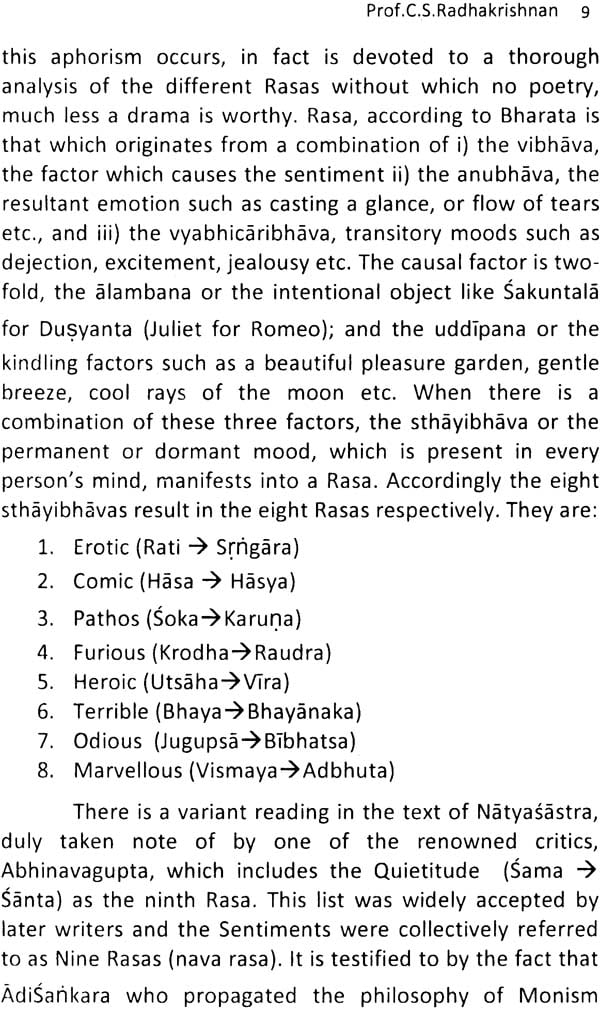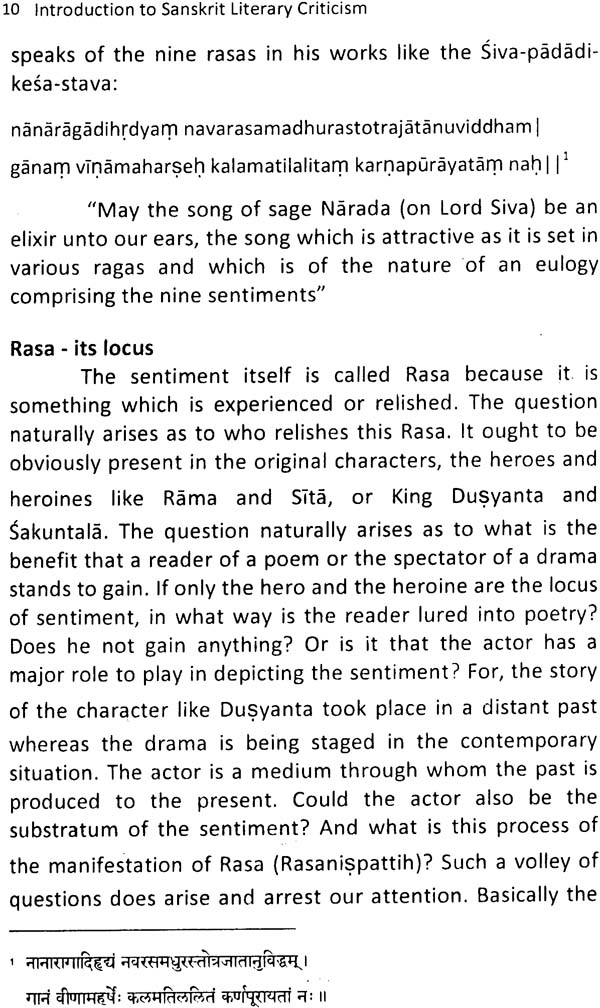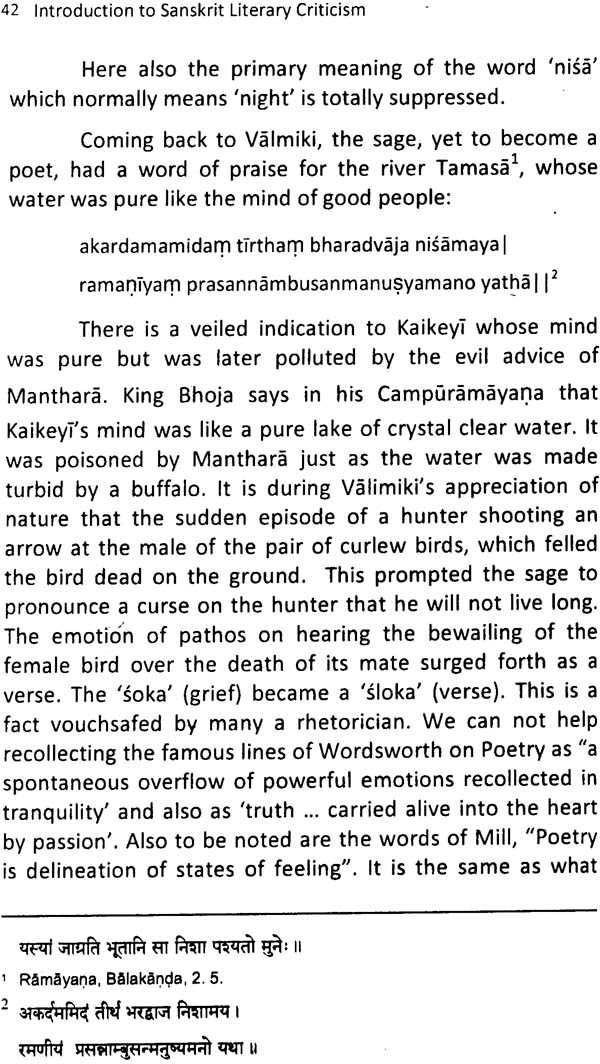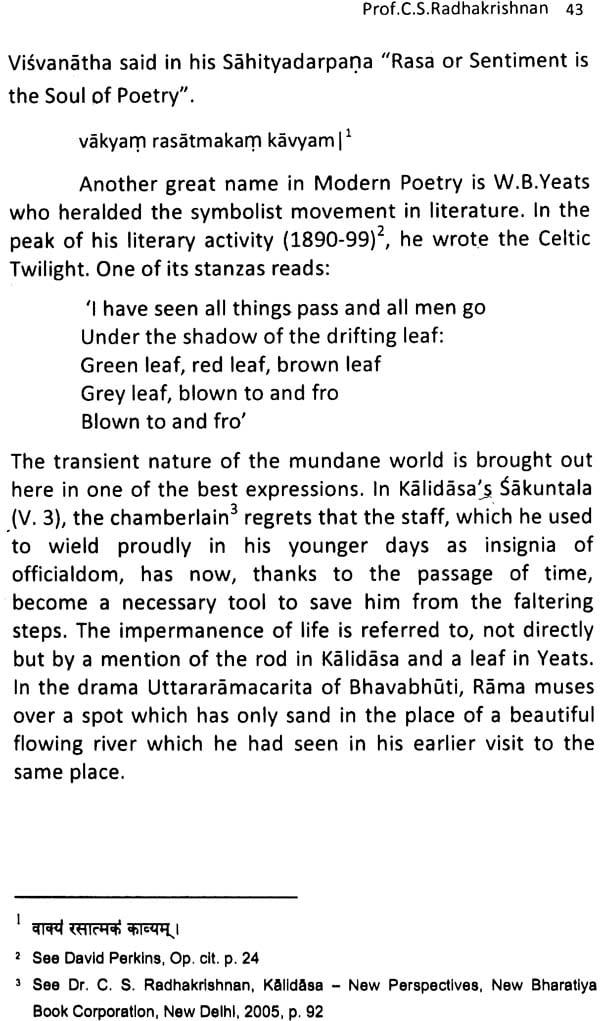
Introduction to Sanskrit Literary Criticism
Book Specification
| Item Code: | NAD300 |
| Author: | Dr. C. S. Radhakrisha |
| Publisher: | Osmania University, Hyderabad |
| Edition: | 2010 |
| ISBN: | 9789380171081 |
| Pages: | 53 |
| Cover: | Paperback |
| Other Details | 8.5 inch x 5.0 inch |
| Weight | 100 gm |
Book Description
Dr. C.S. Radhakrishnan had his schooling in the Veda Sastra Pataskala Sanskrit High School at Chittur, Plight. Attercompleting his MA. Sanskrit with first Rank from the University of Madras (1976), with three gold medals, he did his Ph.D. under Dr M.Narasimhachary, University of Madras. His thesis “Sathavairivaibhava-prabhakara A Critical Edition and Study” was published in 1988. His book “Kalidasa New Perspectives” was released by Prof.Bryzky during the Kalidasa Samarth at Ujjain in 2005 He has also authored three Sanskrit dramas staged by Sanskrit Academy, Campbell and Swami Vivekananda Yoga University, Bangalore. After serving in Vivekananda College, Chennai for twenty eight years, he is now the Professor of Sanskrit at Pondicherry University. He has guided nearly twenty five scholars for Ph.D. and Mephitic. He has also presented more than twenty five papers in International Conferences and more than forty in National conferences. He chaired a Session of the World Hindu Conference at Durban Westville University at Durban, South Africa and a Session of the lot World Hindu Conference at Bangalore. He was elected as a member of the Consultative Committee of the International Association for Sanskrit Studies during the 13 Session at University of Edinburgh, Scotland. The countries visited by him include Singapore) Hong Kong, China, Australia, Thailand, Indonesia, Cambodia, South Africa and London. The title “Sanskrit Rattan” was conferred on him in 2008 by the Scholar Subramanian Ayer Trust, Chennai.
I have great pleasure in introducing to the lovers of Sanskrit the monograph “Introduction to Sanskrit Literary Criticism” by the well-known savant Prof. C.S. Radhakrishnan. In this he has taken up certain topics of Alankãrasãstra — it was in this term that ternary criticism was known in ancient India. The first topic is the birth of poetry or what is called kãvya in Sanskrit. Grammatically the term is explainable as cavers behave karma vain, the mode of a poet or his activity, though later it was defined by the great rhetorician Bhãmaha as the togetherness of word and meaning: wbdãrthau shiatsu kavyamjhe view echoed by Magma in his famous line satkavir via dva yam video ape sate, where, reliance on fate (fatalism) and exertion of a wise man is compared to the dependence of a great poet (stave) on both, the word and the meaning, or in other words the expression and the thought. It is a matter of deep thought as to why in Indian tradition it is soda; expression that precedes Aretha, thought while as per the norm it i thought that should precede expression. It is thought that first appears in mind. It needs an outlet and it is words or expression that provide/s it with the same. Words are the means for expression of thought. Now if the means are weak or inadequate, or disjointed, even the sublimes of thoughts would remain confined in their fullness, to the minds of Speakers. Hence the Importance of the means, soda and their precedence, purgative, over orphan in the Vanda compound where precedence of the compounded words is governed by three principles each is succeeding one overriding the earlier one. One, words having fewer vowels should come first: alpactaram (Pan.2.2.34), two, word beginning with a vowel and ending in short a should come first (Pan.ajadyadantam (Pan.2.2.33), three the word that denotes a thing more honorable than the other (Vartika. Abhyorhitam ca under Pan. 2.2.34). Now, as per the first principle it should be Aretha which should precede soda (the second principle does not apply here; both soda and Aretha having the same number of vowels) on account of its beginning with a vowel, Ajani ( so far as their ending in a concerned, both are on equal footing), Still it is soda that precedes Aretha. The only explanation that could be offered for this is that it is taken to be more honorable, abhyarhita, than the other. Dan din is right in terming it as light, jyoth that lights the world, àsamsãram depilate. All feelings, sentiments and emotions would remain pent up in mind in the absence of word, the great mystic power that almighty has invested it with, the power called abdabrahman.
It is left to the most creative genius to manipulate this power, to harness it for optimum result. All the modes, forms and styles of writing, diction and tenor are an attempt at this. And it is that distinguishes ordinary matter of fact, venal, writing from the most sophisticated one that flowers into an artistic creation. Thought and expression have to combine, sabdãrthau shiatsu to reach this magical and splendid consummation.
It may, in passing, be mentioned here that the word sãhitya for literature that has gained wide currency in Sanskrit literary circles is nothing but a short form of the fuller expression sabdãrtha sahitya just a utsikta, literally sprinkled over, is that of darpotsikta, sprinkled over with pride or ádhmãta, puffed up of darpddhmata, puffed up with pride, the word pride being omitted even in English.
The kavya goes back in India, as rightly pointed out by our author, to the Vedic period itself where it is of frequent occurrence. There are beautiful poetic flashes in the works of the period all through. This trend continues down to the period of the epics and the Purana reaching its acme in the works of the classical and the medieval periods. People down the ages have enjoyed these flashes. This enjoyment is what Rasa is. Our author has expounded in detail the different interpretations of the same by such authorities as Lolita, Hanukkah, Nãyaka and Abhinavagupta of Bharata’s Sutra going by the name Sarasota in the circles of rhetoricians: vibhávãnubhavasancari samyogad asana spattih. All these interpretations of the said sutra framed in the context of a dramatic performance are dictated by the quest as to how the feelings, movements and actions in a dramatic performance or in a poetic composition could be a source of Rasa, relish of the spectators or the listeners far removed from the original ones who would have been the ones Involved In them.
Our author has taken note of the treatment of poetics in the Agni- purana, a work of encyclopedic proportions which has something of every discipline. He has also analyzed the Guan School with reference to Dan din as also taken note of later rhetoricians like Vãmana, Kuntaka, Bhoja and so on. He has thus presented a conspectus of the ancient Indian literary Criticism. The reader can get a fairly good glimpse of the basic concepts of the same from the present work. To that extent it deserves warm welcome by connoisseurs and general public interested in having an In-depth appreciation of ancient Indian literary criticism.
During my nearly three decades of teaching and research, I had many occasions to interact with students and scholars who evinced a keen interest in knowing about the principles of literary criticism in Sanskrit. There are,, of course, many authoritative books on the subject by experts like Dr.S.K.De, Dr.P.V.Kane, Dr.V.Raghavan and others. It was not only the students of Sanskrit but also others who wanted to get a glimpse of what rhetoric is all about in Sanskrit. Now that the Choice-Based-Credit System also has been introduced in the Universities and College Curriculum, I felt the need that a precise survey of the Sanskrit literary principles will be of considerable help to students and general readers alike. The present book is an outcome of such a felt need.
Literary Criticism is a well established fields in many a language. The Lamkara Sastra as it is popularly called in Sanskrit had its own hoary past. It has also been growing ever since, accommodating into its fold new theories and concepts as they emerged from the critics. In fact, though such a field had not taken shape during the Vedic period, a considerable number of figures of speech can be even illustrated with Vedic passages whose poetic flavor has its own charm. There is a well-known saying that great men think alike. So do poets. Or it should be said that their thoughts have so many similarities even though originating independently. The similarity is not only among Sanskrit poets but among poets of all languages and countries. This striking similarity prompted me to annex a small section at the end of this book under the sub-heading ‘Poetry and Poetics — The East-West Reckoning’. This is just an attempt to show how principles of Sanskrit literary criticism can be related to other literature as well just to understand the full ramification of it.
I am very much beholden to Dr.Satyavrat Sastriji, Former Vice-Chancellor of Jagannath Sanskrit Visvavidyalaya, and inana Pitha Awardee, the first Sanskrit scholar to get it, for writing the Foreword for this book. I consider this as my great fortune that a scholar of his eminence has found time to write the Foreword thereby encouraging such sincere ventures of mine. I am reminded of what Kalidasa said “prayah pratyayamridatte svagunesu uttamadarah”. I consider the words of Dr.Sastriji, a great Sanskrit poet of our times, as a blessing on my humble self. I am very much indebted to Dr.SrinivaSa Varakhedi, Director of Sanskrit Academy,V Osmania University for taking up the publication of this book. I wish to thank Smt. Jayanthi Balaji whose abiding interest in drawing parallels between Sanskrit and English quotations inspired me. Thanks are also due to Dr,DevlpraSad Mishra, Research Assistant at the French Institute of Pondicherry for type-setting the entire material into computer. I thank my student Mr.Prasanth Kumar Sethi for preparing the Index.
Literature and literary appreciation have not received the due attention of people. it appears to be the pursuit of a select and fortunate few. Life becomes more meaningful if man, who alone has the faculty to do so, enjoys literature in its myriad aspects. If this book serves the purpose of giving in nut-shell what the vast field of Sanskrit literary criticism has to say, and if it kindles many young minds to go deep into it with a sure possibility of comparative study, then I will consider my end evour amply rewarded.









